
[Editor's note: with the new Jhoira avatar on Magic Online driving interest in its own format, we figured it was a good time to look back at this article, describing the grand fun of Momir Basic. Enjoy the article, and if you have MTGO, enjoy the format!]
For those of you who spend most of your Magic time in the real world (good for you, MTGO is a very ‘spensive habit) you probably haven’t heard of Momir Basic, the delightfully wonky format that spawned up on MTGO soon after the Dissension release events. I’ve never played a real game of Vanguard Magic. Constructed of whatever flavor just doesn’t quite appeal to me in the online world. It takes a huge investment and everyone else is ten times better than you anyway. If I’m going to get beat up for my lunch money, I’d at least like a chance to spit defiantly in my opponent’s face.
But limited is another matter. In limited, everyone starts out with more or less the same chance at victory. Deck conceptualization and card hunting don’t come into play. It balances things out for people like me who have no concept of how to construct the perfect 12-card combo, nor the patience to haggle day-and-night for just the right playset of rares to balance out my collection.
That’s what makes Momir Basic so great. It requires an absolute minimum of investment, and your deck is competitive with every other deck in the tournament. I’m going to say this a lot because it is the best part. Your deck is equal to every other deck in the tournament. How many times do you know going in that you’re on an even keel? Well, that pretty much describes all of limited, actually, so often I guess, but that’s what draws most people to limited. It’s certainly what drew me.
First, let’s review the rules. For those of you who are already well acquainted with how Momir Basic works, and the slightly funky rules that govern creature tokens, you can skip down to the section titled ‘It’s all luck’.
Deck Construction

The obvious and simple build is a straight 12-12-12-12-12 construction with an equal number of lands of each type. This is best for beginners. There are lots of folks who think you ought to mix it up a little, but the debate as to how and why hasn’t really been settled.
The ideal deck would have a lot more red in it, but the 60 card mountain deck loses its ability to deal out awesome effects like Trophy Hunter’s. 20-10-10-10-10 tends to work for some people, but I think this unfairly shoves islands and swamps in the same category as plains and forests. They aren’t.
In terms of useful activated abilities, removal is king. And to that end, most of the best abilities cost red, then black, then green and blue, then white. This is not the order of the colors that have the best abilities, this is just the order that they tend to come up. Green and blue are pretty even here, so they’re lumped in the same category.
When playing your lands, try to keep the option of dropping colors like blue or green back until you get a creature that needs that color of mana, otherwise, you could end up with a landwalking liability and no color-specific gain for your trouble.
Tokens Tokens Everywhere.
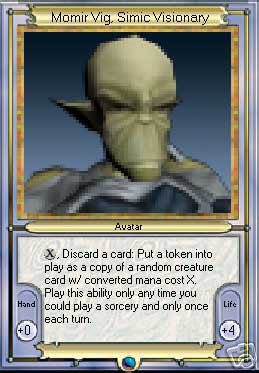
Starting hand size: +0
Starting Life Total: +4
X, Discard a card: Put a random creature into play with converted mana cost X. Play this ability only once per turn and only whenever you could play a sorcery.
The keyword here is random. What this amounts to, is that out of all the creatures with converted mana cost (CMC) X that MTGO knows about, it picks one at random and puts a token copy of it into play for you. At 1 CMC there are 231 possible creatures; at 9 CMC, there are only 21, so the chances of getting what you’re looking for are better. You can activate Momir for zero, if you really want that Ornithopter, but you only have a 1 in 3 chance of getting it - it could be a Phyrexian Walker, or a Phyrexian Marauder which will promptly die. In almost all cases, it’s not worth the cost of discarding a card, but if you really really need to chump block a flyer and keep your mana open 1 in 3 are not bad odds in Momirland.
The creatures you put into play are tokens. This means that they aren’t quite the same as creatures that have cards attached. The most notable difference is that, although tokens do trigger ‘goes to the graveyard from play’ effects, they poof when they get there, or anywhere else for that matter. Tokens cease to exist as a state-based effect when they go to any zone other than in-play. This makes cards like Temporal Adept much much more powerful than one usually thinks of them, but on the other hand, cards like Stampeding Serow are downright useless.
Tokens can be flipped, even if they would no longer be creatures, so long as flipping doesn’t involve leaving play. Student of Elements could be flipped (with Wind Dancer for instance) because it doesn’t change game zones to become an enchantment. Homura, Human Ascendant however, would not flip because there would be nothing left to put back into play.
Tokens can become face-down morphed cards if an effect would morph them, and if they have the morph ability they can turn face up again, but if they don’t, they’re stuck as 2/2s. Creatures with morph always come into play unmorphed. Their converted mana cost is what’s printed on the card, not three. Playing the 3 mana slot will not result in a random, morphed creature.
Tokens put into play by Momir aren’t spells and they were not played from your hand. This makes the Myojin into little more than expensive chump blockers, and it makes Phage the Untouchable into the worst kind of liability.
X is zero. Except in the case of Petrified Wood-kin and other cards like him where X is awesome (but in general, it’s better to drop the creature before you attack because haste is much more common than bloodthirst). Generally what this means to you is that cards like Suncrusher and Draining Whelk aren’t that great. Creatures with graft still get their counters because the counters are a result of the creature coming into play and not the result of any extra costs you didn’t pay. Any extra costs, like kickers, are considered to be unpaid no matter what kind of mana you used to activate the Mo-Meister.
MTGO has the annoying quirk of giving tokens really small text boxes. In the case of some of the more complicated critters out there, it can be literally impossible to read what they do. In these cases, you can get the entire text to display if you just hover your mouse over the creature you want to read and look to the left.
In all other respects, treat your creatures just like the creatures they are copies of.
It’s All Luck...
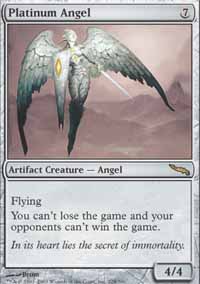
“Why don’t we just flip coins for packs, then.” One spectator asked. “If everything’s random, it’s just about who gets the luckier creatures.”
“Luck does play a role...” I began.
“It’s about 60% luck and 40% skill,” one of the other players supplied. Everyone in the room agreed that this was an apt assessment.
With what I’ve learned in the course of writing this article, I’d revise that percentage a wee bit. Momir Basic is 40% luck 40% skill, and 20% strategy.
I separate strategy from skill because it really doesn’t take skill to implement a strategy. Strategy, simply put, is how you decide when to play cards and when to hold them. Determining whether or not to alter your strategy may take skill, but determining which strategy to implement doesn’t. More on that in a bit.
Top Ten Reasons to Play Momir Basic Premier Events
10. Even if you’re bad, you could win.
All of Magic has some element of luck to it, but when you go to put that 7 CMC creature into play, you never know if it’s going to be Platinum Angel, or Phage the Untouchable. Sometimes, the cards just fall in your favor.
9. Even if you’re good, you might lose. It will be good for your ego.
8. Haven’t you always wanted to ride a deck of 60 basic lands to victory?
7. Bogardan Hellkite.
Every time a new set is released in MTGO, the creature base of Momir Basic is updated to include the newly available creatures. It makes for a slightly newer Momir experience every few months.
6. The payout is in Time Spiral packs.
This, coupled with number ten, is enough for most people. The average Momir queue fills with between 24 and 30 people giving you about a 30% chance of making top eight in any given game.
5. No unexpected combat tricks.
Not having to worry about what those two cards in your opponent’s hand are adds a remarkably agreeable dimension to the game. Removal and tricks are still a part of the game, but there are no surprises. Everything your opponent has at his disposal to stop your attack is right there on the board. You might not notice everything, though.
4. Unexpected pleasant surprises lurk around every turn.
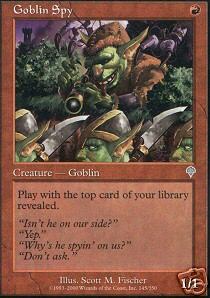
3. Little metagame knowledge required.
This is especially nice for beginning or casual players. One of the things that can be daunting about tournament Magic is that it requires an intimate, almost ungodly knowledge of all the cards out there that your opponent could possibly have. I once had a guy tell me that I should memorize the order in which commons occur in packs so I can have an edge in drafting. That seems a trifle ridiculous to me, but that’s probably why he has the pro points and I don’t.
2. It’s cheap.
This is the best thing about Momir Basic. All you need is a Momir avatar and 60 basic lands, and suddenly you have a top-of-the-line deck that is competitively matched with every other deck entered in the tournament. Momir avatars can only be bought from other MTGO players, so there are technically a limited number available, but since the tournament queues rarely fill beyond 30 people it’s safe to assume that demand is low enough right now. You can buy a Momir avatar (make sure it’s the Vanguard avatar and not the Dissension rare card) for about 5 tix from the bots these days. Ask around and you might even be able to find someone who will throw in 60 basic lands for free. That leaves you with 5 tix left over from your starting coupon, and it only takes 6 tix to enter a tournament.
1. It will make you a better player.
Learn to walk before you run, as the old cliché goes. Momir Basic is a format of full information. You and your opponent always know everything you need to know about the game. Playing this format is a great way to learn to read the board. In most games, the player that loses makes some fatal mistake, although it isn’t always obvious what.
Strategy (Yes, there actually is strategy in such a wonky format.)
At first glance, it appears to be a kind of helter-skelter melee determined by who gets the luckiest creature drops. This is completely true, but there are things you can do to help ensure your drops are a little better than your opponents. First, I’ll tell you the conventional wisdom and then I’ll tell you why it’s wrong.
Conventional Wisdom.
After a few practice games and some interviews with other seasoned players, I came up with the 8-drop strategy. It has a lot of appeal because it’s easy to play, and it puts you where the removal is. It is based upon the very true principle that if you can get to a better (read: higher) mana slot than your opponent you will usually win. You should always skip your first drop if you’re playing second, and your first two drops if you’re playing first. That way, you can drop a creature every turn (provided nothing funny happens to your hand) and by the time you have to start choosing between playing a land or discarding it to make a creature, you’re already in a very powerful, removal-rich slot.
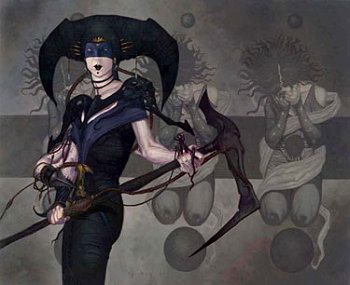
Whoa Baby!
Sundering Titan It may not be creature removal, but it’s devastating none the less. Especially to silly opponents who have played one land of each basic land type.
Ashen Firebeast This one is so-so, but it has the potential to sweep the board free of annoying tricksters while leaving fatties intact.
Avatar of Woe Whoa!
Bloodfire Colossus He rocks your socks off. And everyone else’s. And your opponent’s life total. A very good drop.
Bogardan Hellkite This guy is perfect in every way. It’s rare that you aren’t happy to see him.
Hoverguard Sweepers The holy grail of drops in Momir Basic. I’ve never seen a game in which a player who got these guys lost. Unless his opponent got them next.
Living Inferno He tends to trade for another fatty soon after arriving, so he’s not quite as versatile as he looks at first glance. Still, a welcome sight.
Sanguine Praetor This guy is awesome, but tricky. Knowing how to use him and when makes all the difference in the world. Remember that if you need to pop an 8 drop, you’ll lose your Praetor too.
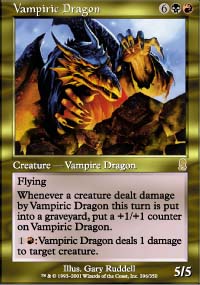
Maybe not eating people is
the first step to making friends.
Bosh, Iron Golem This guy has won me many many games. The ability to sac himself to himself and sling 8 damage wherever you want it is usually enough to finish your opponent off.
Sisters of Stone Death Remember when you force blocks that other creatures can also block. These girls tend to get ganged-up on and taken out early, but not before they have a chance to take one or two others down with them.
And that’s not even mentioning other stars like Akroma, Angel of Wrath and Razia, Boros Archangel. Eight drops are a good place to be.
What I used to do, and let me remind you that this strategy is not exactly optimal, is skip the first two drops, maybe dropping something if I was facing too many threats, but making sure to skip a drop later so I’d be in the eight slot for the final run of the game. I tried to play only mountains and swamps, because these were the two colors most likely to be needed for activated abilities, and occasionally I would drop plains or forests if I had to, or if I had something that needed them, but never islands unless there was an obvious and direct benefit. Too many high casting cost things either have islandwalk, or can’t attack you unless you control an island. I tried to keep my total number of basic land types in play restricted to 2 or 3 in case my opponent got a Sundering Titan.
This strategy didn’t really work all that well, but I put down the fact that I made top eight in only about 1 in 4 tournaments to the vagaries of the format. After all, Momir is a harsh mistress.
The Aggressive Strategy
Then I started doing some research and I stumbled upon this little gem of an article on Wizards’ main site. It seemed a bit too brief for my taste, but it has a handy dandy table in it.
“Never memorize anything you can look up" -Albert Einstein
http://www.wizards.com/default.asp?x=mtgcom/daily/fk13
I would like to add that in the two-drops, Tempting Wurm is a total hoser. If you have the misfortune to play this guy, you’ll probably never recover, but that doesn’t mean you should avoid making two-drops. You’re just as likely to get a Werebear.
The thing about this article that really got me thinking was samdsherman’s comments about the aggressive tack (dropping a creature every turn and using them for early damage and late chump blockers while you skip drops to play more lands). It ran so counter to the accepted wisdom of how to play Momir that I’d never really tried it. I decided to give both strategies a run in the casual room.
I played ten games using each strategy and recorded the outcome. 6 of my opponents quit out before the game was up, one of the reasons I hate casual, so I ended up playing 8 of each game that actually counted (I had to play extra until it was even). Of these, I won 3 of the ones using the cautious, 8-drop strategy, and 6 of the games in which I used the aggressive strategy. One of those losses was my fault for not being aggressive enough. I could have squeezed an extra 4 damage out of my opponent by attacking with 3 2/2’s but I held back because he had a 6/6 blocker. Those 4 damage ended up costing me the game, and that extra living 2/2 knight did nothing for me.
Obviously the aggressive angle has merit. I did a bit more testing and I found that often, when using an apparently aggressive strategy, the opportunity to skip a drop occurs. This is usually because you have something better to do with the mana that turn, and occasionally it’s because you’re kicking so much butt, you can afford to wait a turn to drop another creature. It was very rare that I would play a game in which my coveted eight-drops didn’t become available to me. I developed a synthesized strategy of aggressiveness, with an eye to long game, should it come to that.
So I took these newfound strategies and put them to the test. I found myself joining a Momir Basic tournament at 9 pm on a Thursday night. I got to have a nice long talk with my girlfriend about what possessed me to do such a thing when I had to be at class at 8am the next morning.
The worst part is, there is no good excuse. I knew that I couldn’t possibly handle the Thursday-night tournament, I told myself I was only logging on to check the tournament schedule and maybe plan one for Friday night. I just joined the Momir Basic tournament room to talk to people about the format. Next thing I knew, I was signing up with the intention of dropping before it started. I have a problem. I really need to step back and curb my Magic Online. Seriously. Before I get kicked out of my house.
Then again, maybe it was serendipity. The tournament went really well. I was undefeated in the first five rounds. It was late in round five when I realized that both of the players mentioned in the article on Magicthegathering.com were in this very tournament with me.
The Tournament
samdsherman was complaining to someone else in the room: “I got sick of this game a while ago, but it’s a (blank)ing cash cow.” He went on to say. “People are like, ‘Oh hey, you’re the Momir guy, can I challenge you to a duel. And I’m like ‘no I’m sick of the game I’ll never play Momir again.’”
“Oh, you were mentioned in the article on Magicthegathering.com." I said unnecessarily. "My condolences.” He didn’t seem to be in the mood for an extensive interview, and I had last minute schoolwork to work on, so I didn’t press him.
Until a few rounds later when we were the last two players standing. Final round, winner gets twelve Time Spiral Boosters, loser has to make do with only nine. The pressure was on.
I asked him if he wouldn’t mind my quoting his earlier comment about not liking Momir BASIC anymore.
“Did I say that?” he asked innocently. He is, after all, the head of the Momir lovers’ guild.
“Your exact words were: ‘I’m sick of the game. I’ll never play Momir again.’” I told him, “but I’m taking that a little out of context.”
“I don’t hate the game,” he told me after a few moments consideration. “It’s just not as much fun as it used to be. It’s starting to feel more like a job.”
One with lousy pay. It costs 6 tix to join a Momir-Basic Premier Event, and even if you knew for sure that you would come in first place every time, (I hope I don’t have to point out how ridiculous this is) the 12 packs you get can be sold for something in the neighborhood of 4 tix each. That’s 42 tickets profit for 8 hours work. You’d make better and more consistent money waiting tables or flippin’ burgers.
But I bet you want to know how the game between myself and the Momir-Guru went.
Game one
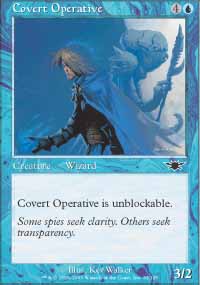
“You don’t play swamps?” I asked.
“Obviously. Metagame against Anaconda,” he told me. I couldn’t tell if he was joking or not. Lotsa things have swampwalk.
To make matters worse, he followed up my Anaconda with a Covert Operative. This thing is hard to play against. It almost always wins games. If you can get any consistent evasion in Momir Basic, hold on to it at almost all costs. The converse is also true - if you see consistent evasion, kill it at all costs!
He followed the operative up with an Adarkar Valkyrie just to make my defeat more humiliating. I prayed for a flyer and got a Draining Whelk. Then I forgot to block because I was making notes on the game and ended up losing a turn or two earlier than I would have. Obviously, the Momir gods like this guy.
Game two.
He drops a Timberwatch Elf, and I get stupidly hosed by double-blocking his Tel-Jilad Outrider and not realizing that it’s also an Elf. Ick. Then he drops Covert Operative. Again.
This is why he’s the master.
We Can't All Be Winners...
I have played a total of 4 Momir Basic tournaments using the aggressive strategy and I’ve hit the top eight in 3 of them. Aggro tends to win against defensive opponents who skip their first drop or two. If you can get the tempo in your favor, the advantage of having extra creatures and life will usually see you through to victory. Even if you don’t end up with something else to use your mana on, and therefore an opportunity to skip a drop, being in the 6 drop slot isn’t that bad to be stuck on. It has competitive creatures, and can hold its own against a 7- or 8-dropper in the short term.
The problem, of course, is that if your opponent is also using the aggressive strategy, your edge disappears. It all comes down to who gets better creatures and who makes worse mistakes.
I thought that was what we were trying to avoid. All this talk of strategy was supposed to give us an edge.
Well it does. Despite the fact that the aggressive strategy is common knowledge and readily available to anyone willing to take the time to read about it, less than one third of the players in any given tournament seem to actually use it. I had an opponent who somewhat incongruously told me that I was the worst player he’d ever seen, but also the luckiest. I tried to convince him that my undefeated record was a result of my ‘wrong’ strategy, but I didn’t try too hard. He didn’t want to hear it.
There are lots of people out there who just can’t play aggressively. Throwing creatures into an attack in which some of them will die without trading is something that some people will never do unless it wins the game this turn. These are the same people who don’t activate Trespasser Il-vec’s ability because they can’t bear to trade the cards in their hand, which represent potential power, for a known quantity of real power in the form of damage.
Heck, usually, I’m one of them. Caution has saved me more than my share stupid mistakes.
But sometimes you have a better shot at victory when you throw caution to the wind.
Comments